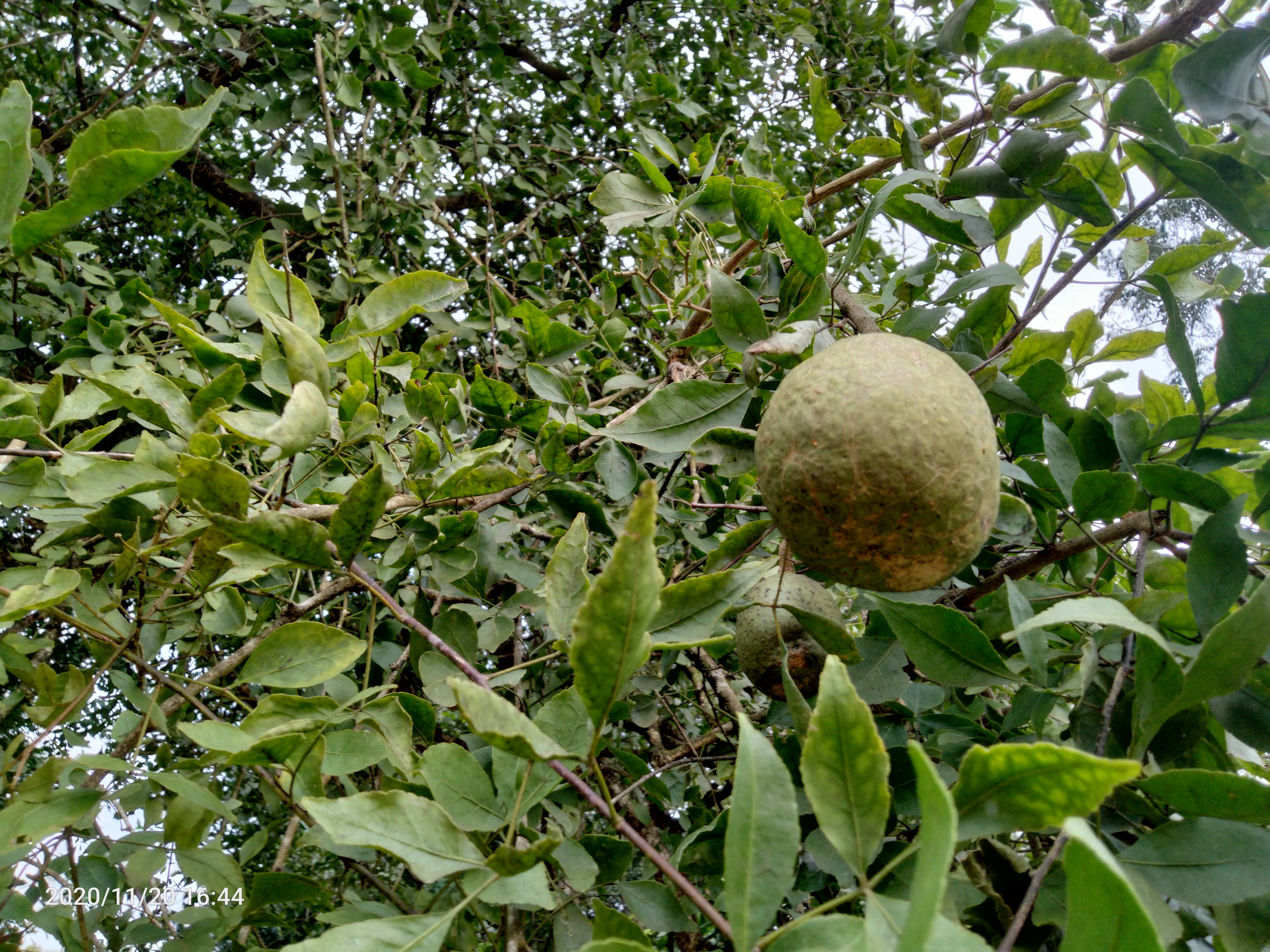Description
Aegle marmelos is a rare species of tree native to the Indian subcontinent and Southeast Asia. It is present in India, Bangladesh, Sri Lanka, and Nepal as a naturalized species. It is a deciduous shrub or small to medium-sized tree, up to 43 feet tall with slender drooping branches and a rather open, irregular crown.
The fruit typically has a diameter of between 5 and 10 cm (2 and 4 in). It is globose or slightly pear-shaped with a thick, hard rind and does not split upon ripening. The woody shell is smooth and green, gray until it is fully ripe when it turns yellow. Inside are 8 to 15 or 20 sections filled with aromatic orange pulp, each section with 6 to 10 flattened-oblong seeds each about 1 cm long, bearing woolly hairs and each enclosed in a sac of adhesive, transparent mucilage that solidifies on drying. The exact number of seeds varies in different publications.
The fruit takes about 9-12 months to ripen on the tree. It can reach the size of a large grapefruit or pomelo, and some are even larger. The shell is hard and must be cracked open. The fibrous yellow pulp is very aromatic. The Fruit and other parts of the tree are also used in traditional medicine.
Varieties: There are many local Beli species. At present, the local beli varieties are mainly known as elephant beli and medicine beli. There are many species of beli according to the characteristic differences in the size, color, shape of the fruit, the amount of seeds and the growth style of the tree.
Planting requirements
Planting season: February to April
Planting conditions:
| Propagation | Direct seeding, cuttings, grafting, or root cuttings |
|---|---|
| Planting method | Seeds from ripe fruits are cleaned and planted in a nursery, germinating in 8-10 days. Spacing is 6x6m for seedlings and 3x3m for transplants. Seedlings with 2-3 leaves are moved to pots with a soil mix. After 9-12 months, they're ready for field planting in 60x60x60 cm holes filled with enriched soil |
| Soil | Beli grows uniformly even in soil with pH varying from 5-10 (strongly alkaline). Grows best in well-drained soils |
| Water | Does not require regular watering once germination is complete, rainfall should be adequate. Monitor soil moisture but do not overwater |
| Light | Full or partial sunlight |
Growing conditions:
| Temperatures | 25-35°C is ideal. But can withstand upto 46°C and as low as 7°C |
|---|---|
| Soil | Ensure that soil is well-drained |
| Water | Rainfall provides sufficient water. Monitor soil moisture |
| Pruning | Prune to encourage new growth and maintain shape |
| Weed control | Mulching helps suppress weeds and retains soil moisture |
Harvesting
Trees grown from seeding will take 7-9 years to bear fruit. Trees grown from cuttings or grafting will bear fruit in 3-5 years. Fruits take about 9-12 months to ripen. Only pluck the fruit once it has ripened as it will cease ripening once removed from the tree. Older trees typically have higher yields. A 15 year old tree should provide a harvest of between 200-400 fruits.
Curing
Beli does not require a curing stage.
Storage
Beli fruit can be stored from 10-15 days at normal temperature, whereas fruit harvested at ripe stage can be stored at room temperature for up to a week. For longer storage, they can be refrigerated for up to 4 months.
Protecting your plants
Pest control
Pest type: Older trees are rarely afflicted by disease or pest infestations but saplings maybe susceptible to various fungal infections and insect infestations
- Slugs: Damage small seedlings
- Leafminers
- Leaf-eating caterpillars
Symptoms: Wilting leaves, yellowing leaves, holes in leaves, sticky honeydew on leaves
Control method: Organic pesticides are effective at pest control. Remove diseased parts of the plant in the case of fungal infections. Fungicide maybe required
- Slugs: They can be controlled by hand pulling and application of agrochemicals like META
- Leafminers: If damage is severe, apply humus extract
- Leaf-eating caterpillars: Apply appropriate agrochemicals if damage is difficult to control by hand
Disease Control
Disease type:
- Powdery Mildew
Symptoms:
- In young stages, the plant leaves and young shoots will show white spots
Management:
- Avoid overhead irrigation, remove infected plant material, use sulphur-based fungicides as a last resort. Spraying agrochemicals containing sulphur or applying fungicides containing copper to irrigation can help control this disease
Sources
In addition to our General List of Sources (link), we used these specific references:
